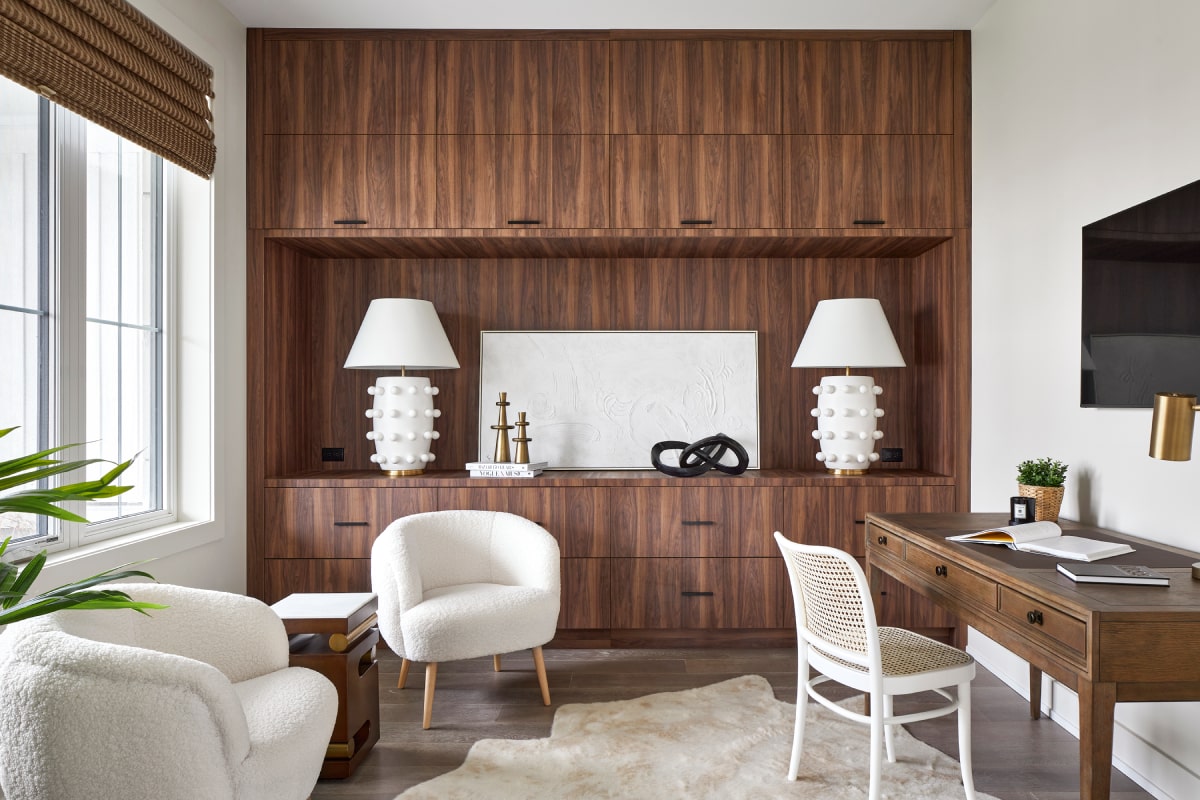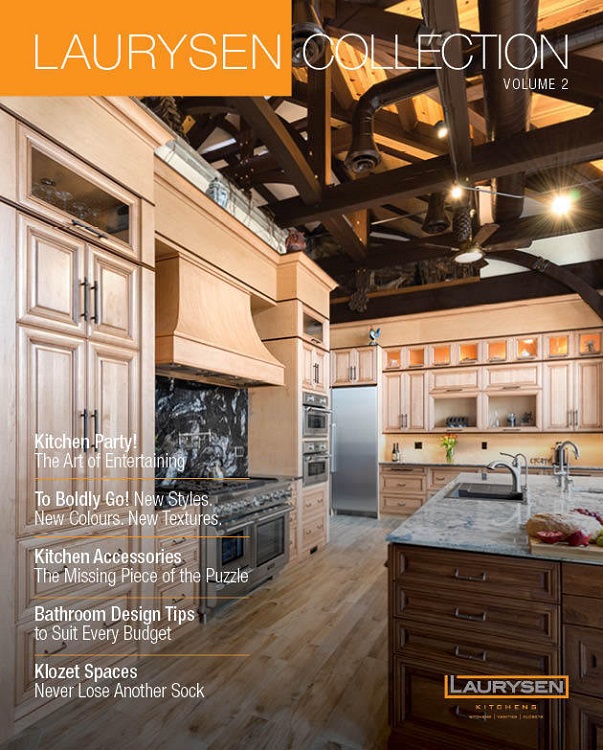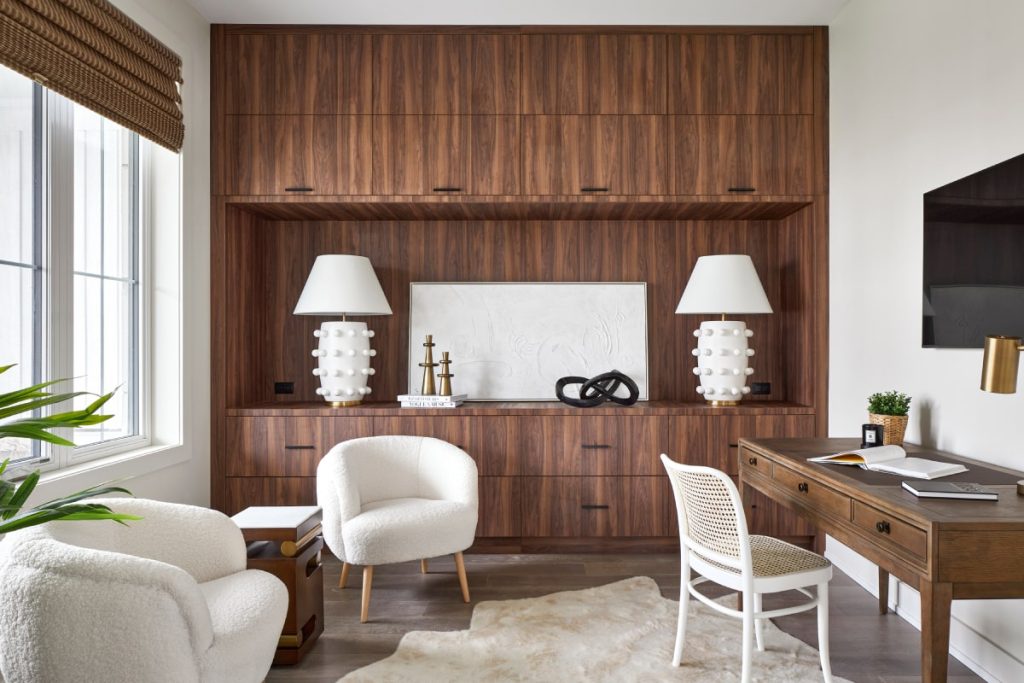
As more people transition to remote work arrangements, having a dedicated workspace that is both functional and aesthetically pleasing has become essential for productivity, focus, and overall well-being.
A well-designed home office can help you separate your professional life from your personal one, even within the confines of your own home. Working from your kitchen table amid all sorts of household clutter isn’t a good way to get work done.
Let’s face it: If you’re going to spend most of your day in your office, you’ll enjoy it a lot more (and actually do a lot more) if you’re working in a dedicated room designed to be exactly what you need it to be. And what better way to achieve that workspace than with a talented Laurysen designer?
We understand that each home office space is unique and needs to be tailored to specific requirements and preferences. Whether you’re looking to maximize storage space, optimize workflow, or incorporate ergonomic features, we’ll work closely with you to design a space that meets your practical needs, reflects your personal style, and adds to your home’s overall ambiance.
1. Hire A Trusted Designer
If you’re looking for a consultation or home office design tips, reach out to our design team. Speaking with and hiring a designer is a crucial step in creating a truly beautiful home office space that will make you excited to sit down and work.
Here’s why collaborating with a professional can make all the difference: They have the expertise and experience to turn your entire room into a functional home office.
Designers bring a wealth of knowledge and experience to the table. They’ve mastered the principles of design and space planning, allowing them to optimize your home office layout into a tailored, functional space. They also understand that your home office should be more than just a small desk with a computer screen tucked away in a corner of your living room. No matter how much space you have to work with, your home office needs to be a work area where you can spend hours at a time.
Not only do they have a great eye for office design, but interior designers also have access to a wide range of resources, including furniture suppliers, manufacturers, and tradespeople. They can source high-quality materials and furnishings that are not readily available to the general public, ensuring that your home office is outfitted with the best products within your budget.
2. Understand Your Space
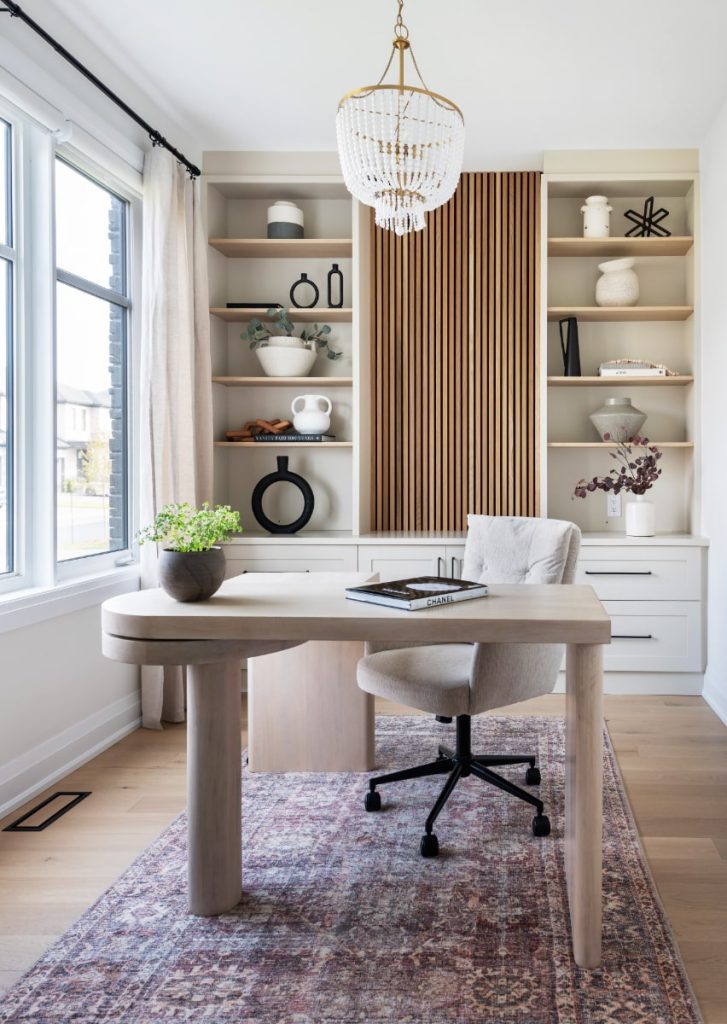
In order to get the most out of the room or area you’re going to use as an office, you’ll need to consider the entire space.
First, take note of the natural light sources in the room, such as windows and skylights. Natural light can enhance productivity and mood, so consider positioning your workspace near these sources to maximize exposure.
If you’re working with a smaller space, every square inch counts. Prioritize functionality and focus on selecting furniture and accessories that serve multiple functions and maximize storage potential. For example, choose a desk with built-in drawers or shelves to keep essentials within reach.
Make use of vertical space to maximize storage and reduce home office clutter – without taking up valuable floor space. Install floating shelves or wall-mounted cabinets to store books, office supplies, and decorative items. Vertical storage solutions can help keep clutter off your work station and create a sense of openness in the room.
Look for furniture pieces that are specifically designed for small spaces, such as foldable desks, nesting tables, or wall-mounted workstations. These versatile pieces can be easily stowed away when not in use, allowing you to reclaim valuable floor space when needed. (This is especially important if your home office is a multi-functional space; for example, it also serves as a guest room.) Invest in storage solutions such as bins, baskets, and trays to corral paperwork and office supplies. By minimizing visual clutter, you can create a more peaceful and focused work environment.
3. Your Desk Matters
Spending long hours seated at a desk can take a toll on your body, leading to discomfort, fatigue, and even musculoskeletal issues. A comfortable chair and desk are essential for supporting proper posture, reducing strain on your body, and minimizing the risk of discomfort or injury.
A good-quality desk and chair allow you to work comfortably for extended periods and can also help you maintain optimal body alignment, reducing fatigue and enabling you to stay focused on your tasks.
The expert designers at Laurysen have plenty of ideas for furniture in your home office area:
- Ergonomic Chair: Look for a desk chair that provides adequate lumbar support to maintain your spine’s natural curve. Adjustable features such as seat height, armrests, and backrest tilt are essential for customizing the chair to your body size and preferences. Consider options with breathable mesh backrests for enhanced comfort and airflow.
- Adjustable or Standing Desk: Ideally, you should get an adjustable desk that allows you to alternate between positions throughout the day. This will reduce the risks associated with prolonged sitting. There are dozens of types and styles of standing desks, such as powered or hydraulic lifts. If you don’t have the budget or space for an entire standing desk, there are monitor stands and adjustable attachments that will raise your monitor, keyboard, and mouse up to standing level.
- Keyboard Tray and Monitor Stand: Supplement your ergonomic setup with accessories such as a keyboard tray and monitor stand to promote proper posture and reduce strain on your wrists and neck. Position the keyboard at elbow height and the monitor at eye level to maintain a neutral posture and minimize discomfort during extended periods of typing and screen viewing.
- Footrest: For added comfort and support, consider using a footrest to alleviate pressure on your lower back and legs. A height-adjustable footrest allows you to find the optimal position for your feet, promoting circulation and reducing fatigue during prolonged sitting.
4. Lighting Can Be Everything
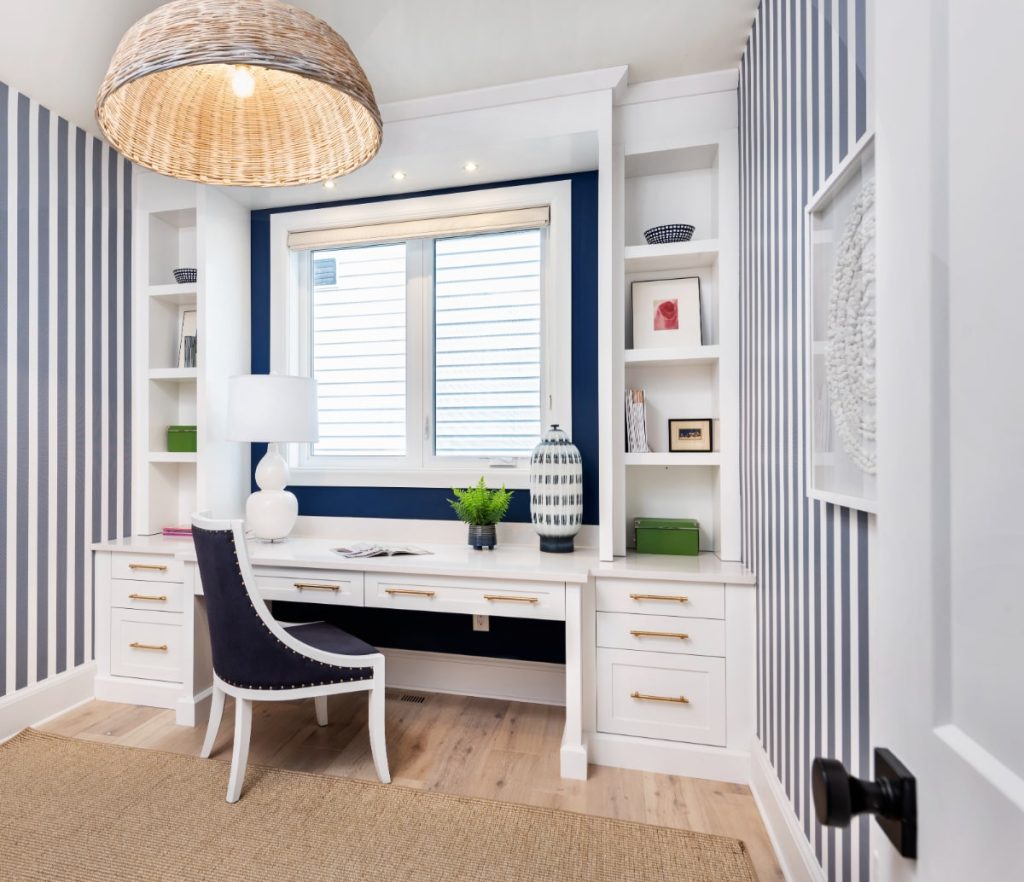
Good lighting plays a crucial role in shaping the atmosphere and functionality of a home office. If your home office’s window allows for plenty of natural light, you should try to keep your curtains or blinds open throughout the day.
If your home office is in a darker area of your house, you should add some desk lamps or adjustable overhead fixtures to provide focused illumination for your desk. Use ambient lighting, such as ceiling-mounted fixtures or wall sconces, to provide overall illumination and create a comfortable and inviting atmosphere in your home office. Soft, diffused lighting can help reduce eye strain and create a sense of warmth and coziness.
If you’re experiencing glare on your screens (or don’t want the neighbours peeking in to see what you’re working on), install sheer curtains or blinds to diffuse harsh sunlight and prevent glare on computer screens and work surfaces. You can also install window films that allow natural light to filter into the room while maintaining privacy.
5. Shelves & Closet Storage Solutions
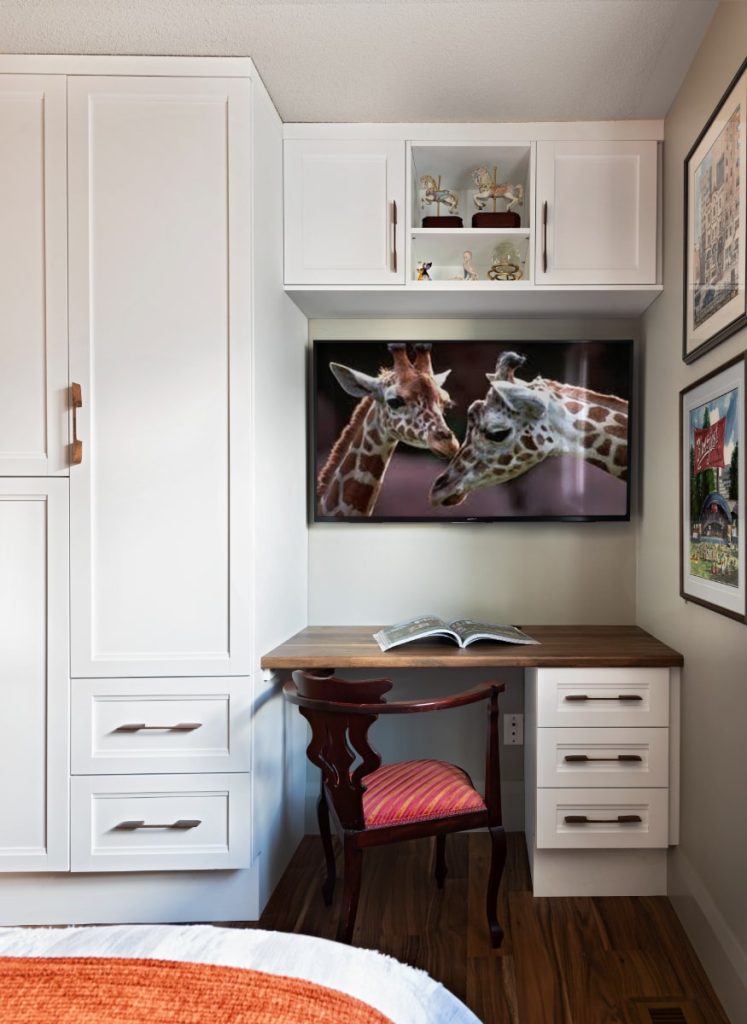
While the right desk or a side table with enough drawers might be enough to cut it, you might want to consider custom cabinetry and custom-designed closets for your storage:
- Optimize every inch of available space in your home office, including awkward corners, alcoves, and underutilized areas.
- Whether you require dedicated space for filing documents, storing office supplies, or concealing electronics, custom cabinets can be designed to accommodate your workflow and organizational style.
- What better way to maintain a clean and organized appearance in your home office than by incorporating built-in shelving, concealed storage compartments, pull-out shelves, and integrated filing systems? Keep unsightly clutter out of sight while providing easy access to essential items when needed.
- Create a custom look that complements your decor and reflects your personal style. Custom cabinets can be designed to seamlessly blend with existing furnishings and architectural elements, creating a cohesive and polished appearance.
6. Personalize Your Space
Personalizing your home office is essential for creating a space that reflects your personality and style. If you’re doing lots of video calls, your office will likely be seen by clients and coworkers. It’s a good idea to use this opportunity to show off who you are! Here are some ideas for adding that little personal touch to your home office design.
- Sentimental items: Surround yourself with items that hold personal significance, such as photographs, artwork, or souvenirs from memorable experiences.
- Accents: Add decorative accents that reflect your interests, hobbies, and passions. Whether it’s a collection of vintage books, a display of your favourite musical instruments, or a gallery wall of inspirational quotes, incorporating decorative elements that resonate with you can enhance the visual appeal and personality of your workspace.
- Artwork: Commission or create artwork specifically for your home office that reflects your unique style. Whether it’s a custom painting, a framed art print of your favourite quote, or a handmade sculpture, personalized artwork adds a touch of individuality and creativity to your workspace.
- Textiles: Add warmth and comfort to your home office by incorporating textiles and fabrics in the form of throw pillows, area rugs, or curtains.
- Furniture: Personalize your home office furniture with custom or vintage furniture pieces, such as a colourful accent chair or a handcrafted shelving unit.
- Seating: If you are lucky enough to have a spacious home office, designate a cozy seating area in your home office where you can read, brainstorm, or simply take a moment to recharge.
7. Technology Integration
Nobody likes to work around a messy jumble of wires and cables. You can minimize cable clutter by investing in wireless technology whenever possible, such as wireless printers, keyboards, mice, and speakers.
While wireless tech is nice, you’re still going to have to deal with wires. Use cable management solutions such as cable trays, raceways, or cable sleeves to conceal and organize cables and cords. Route cables along the back of your desk or behind furniture to keep them out of sight and prevent tangling. You can even use adhesive cable clips or Velcro ties to secure cables and prevent them from dangling or getting tangled.
Your office space should have a specific station for charging smartphones, tablets, laptops, and other electronic devices. Install a charging dock or charging shelf with built-in USB ports to keep devices organized and charged while minimizing cable clutter.
8. Colour Psychology
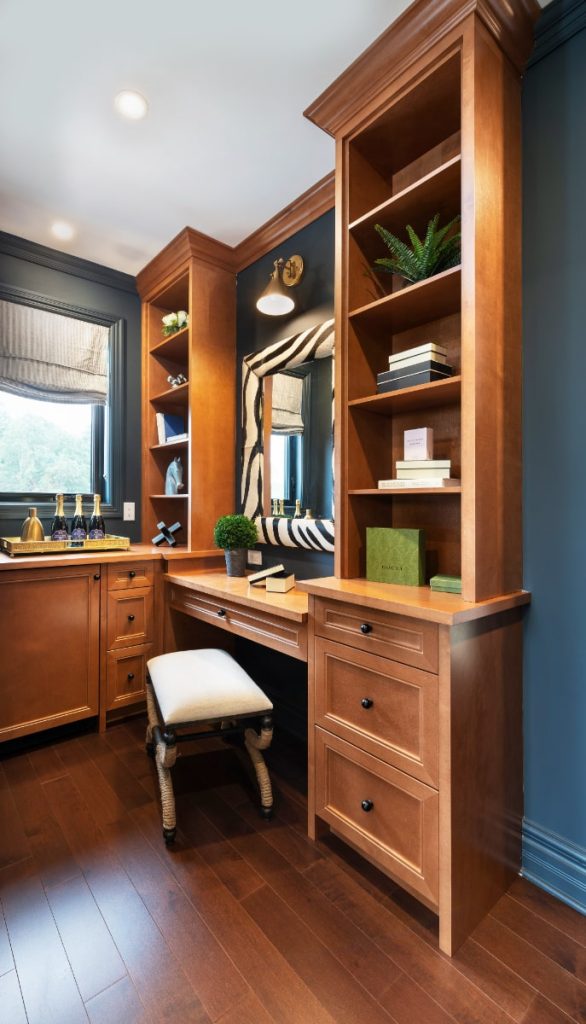
Depending on the type of work you’ll be doing, the colour scheme of your office can play a part in how effective that work is. Calming hues like blues and greens can make for a serene atmosphere—good for busy, high-stress roles that require lots of focus and attention. If you’re looking to boost creativity or energy (say you’re doing a lot of sales calls or drawing art), energizing shades like yellows and oranges can provide a vibrant and stimulating workspace.
Pay attention to the colour temperature of your light bulbs, too. Cool white or daylight bulbs (5000-6500 Kelvin) mimic natural daylight and can help promote alertness and focus during the day. Warm white bulbs (2700-3000 Kelvin) are better suited for evening work sessions, as they create a relaxing and calming environment.
9. Greenery & Air Quality
Incorporating greenery into your home office enhances aesthetics and offers numerous benefits for air quality, mood, and overall well-being.
Plants act as natural air purifiers by absorbing carbon dioxide and releasing oxygen into the room. Research suggests that exposure to nature, even in the form of indoor plants, can reduce stress, anxiety, and feelings of negativity, promoting mental clarity and creativity.
Greenery also does wonders for adding visual interest, texture, and colour to your home office. Plants can soften hard edges, add warmth and character to the space, and enhance the overall aesthetics of your home office.
Some good indoor plant varieties include:
- Snake Plant (Sansevieria)
- Peace Lily (Spathiphyllum)
- Spider Plant (Chlorophytum comosum)
- Pothos (Epipremnum aureum)
- Rubber Plant (Ficus elastica)
- ZZ Plant (Zamioculcas zamiifolia)
Reach Out to Us for More Home Office Design Tips
A good home office doesn’t come down to a nice warm wood desk or a nifty swivel chair. Designing a space that is both functional and beautiful requires careful consideration of a wide array of design choices, from storage planning and the arrangement of furniture to the selection of your mouse and keyboard.
For personalized home office ideas and design solutions tailored to your needs and preferences, contact the experts at Laurysen Kitchens. We specialize in creating home offices that integrate style with utility, and can’t wait to collaborate with you to create the perfect workspace.
